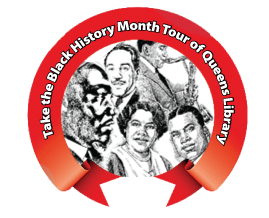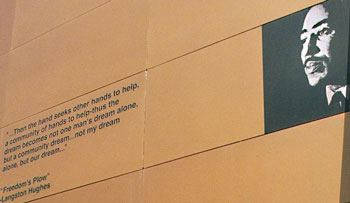They stand looking at the camera, their faces neutral, their armbands reading “LIRR Jamaica.” These five men from Queens are draftees, waiting at the Jamaica Long Island Rail Road station for the train that will carry them to Camp Upton in Yaphank.
It was 1918, the United States had finally entered World War I, and the draft had swept up Americans from all walks of life to train and fight in Europe.
That included African-Americans, many of them eager to fight for their country and for a chance to be regarded as equals. Though African-Americans made up only 10 percent of the national population, 13 percent of those drafted were black. It was a journey that would carry them across an ocean, into the grisliest combat the world had ever seen, and through a constant barrage of racial intolerance.
This photograph from the Queens Library Archives depicts Robert D. Watkins, Charles Robinson, Edward Holling, Charles Walker and Harry Cole: four African-American, one white, all from Jamaica. There were only a few military bases around the country that would train four of them. Around New York City (not counting the 15th Regiment of the New York National Guard, which was formed earlier and trained upstate), that was Upton. African-American men poured into the base from all locations and walks of life, bunking in segregated barracks and training separately from their white counterparts.
“Heavens! What a collection and assortment of men,” remarked Samuel Blount, a black soldier whose writings are chronicled in Chad Williams’ Torchbearers of Democracy: African American Soldiers in the World War I Era. Blount called his soon-to-be comrades “rogues, ‘pimps,’ cut-throats, longshoremen, hod carriers, tramps thieves, students professional men, business men and men who were just plain nothing!”
Williams quotes another soldier, George Robinson, a Virginia Union University student: “It gave me a chance to study different classes which I never realized I would come into contact with.”
Their commanding general, Charles Ballou, was stern about the men’s conduct in order to avoid racially motivated conflict.
“Avoid every situation that can give rise to racial ill-will,” he wrote in an order that followed the arrest of a black soldier in Kansas for trying to enter a theater. “… White men made the Division, and they can break it just as easily if it becomes a trouble maker.”
The order severely damaged morale. The 367th Infantry Regiment, in training at Camp Upton, tore down the directive whenever it was posted and were therefore confined to the base. The regiment’s colonel even later issued a directive saying black officers would not have to require salutes from white soldiers.
The young African-American men in our photograph were probably trained to be part of the 367th Infantry, though the date of the photograph (August 5, 1918) suggests they may have either missed combat or arrived in Europe as replacement troops. But even if they were spared the horrors of industrialized combat in France, they faced other threats much closer to home. Their training at Upton would have lasted around seven weeks — which puts them at the camp exactly the same time as the fearsome influenza pandemic spread there. In the course of 40 days, one-fifth of the camp’s 30,000 inhabitants were hospitalized. The disease would go on to kill 675,000 people in the United States and perhaps 50 million people worldwide, far outpacing the carnage of the war itself.
According to Black Soldiers of New York State by Anthony Gero, black soldiers who made it to Europe also faced contempt and rumor-mongering from white American soldiers in France. Some units were denied pay for a month.
Still, the 367th and a few other New York units, part of the all-black 92nd Division, served with distinction when they arrived in the summer of 1918. Needham Roberts and Henry Johnson, members of the New York-based 369th Infantry, held off 24 German soldiers in the dead of night while guarding their observation post. They killed four enemy soldiers and injured many more, but both were shot and wounded. For their trouble they were simultaneously celebrated and caricatured by an insensitive American press.
The 367th also fought an heroic battle just a week before the Armistice to rescue a trapped French unit from barb wire and heavy machine gun fire. The entire battalion dispatched in the operation was awarded the Croix de Guerre by the French.
Equality did not await these soldiers when they returned home. Racial violence had quieted during the war. But it erupted again, frequently directed against black veterans, who were rightly proud of their service. It would take nearly two more decades and another world war before the United States military desegregated.
But none of that coming struggle is evident on the faces of these young men about train for war. The future, whether it entails death by machine gun or virus, or a return to a civilian United States unprepared to honor their loyalty, is distant and abstract. They just have to get on the train.
Want to learn more about African-American veterans? Stop by the Langston Hughes Library in Corona to look at any of these books from our Black Heritage Reference Collection:
African American Generals and Flag Officers: Biographies of Over 120 Blacks in the United States Military by Walter L. Hawkins
American Patriots: The story of Blacks in the Military from the Revolution to Desert Storm by Gail Buckley
African American Recipients of the Medal of Honor: A Biographical Dictionary, Civil War through Vietnam War by Charles W. Hanna
The African-American Soldier: From Crispus Attucks to Colin Powell by Michael Lee Lanning
Black Faces of War: A Legacy of Honor from the American Revolution to Today by Robert V. Morris
Buffalo Soldiers: African American Troops in the U.S. Forces 1866-1945 by Ron Field & Alexander Bielakowski
Soldiers of Freedom: An Illustrated History of African Americans in the Armed Forces by Kai Wright
Strength for the Fight: A History of Black Americans in the Military by Bernard C. Nalty
War and Race: The Black Officer in the American Military, 1915-1941 by Gerald W. Patton









